

This Mirror Has a Touch Screen Computer Hidden Inside. Holovect: Holographic Vector Display by Jaime Ruiz-Avila. The Holovect Mk II is a self-contained laser-based volumetric display system that fits on your lab bench or desktop.
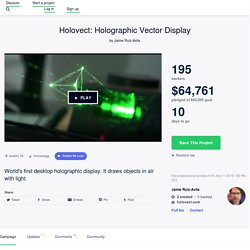
It is the perfect companion to a 3D printer and a stand-alone educational or promotional device. The Holovect Mk II is the first commercially available, laser-based desktop "holographic" display, capable of drawing 3D objects in air with light. Holovect images are NOT holograms but instead volumetric vector images projected onto modified air (i.e. projections in space). This Amazing Robotic Glove Lets You Touch the Virtual World. “Seeing is believing.”

While there may be some truth in the old adage, it forgets a crucial component of how we interact with the world: touch. Touch makes things real. Imagine reaching out to grab your coffee mug, and instead of feeling the smooth ceramic surface pressing against your fingertips, you get…nothing. It’s jarring. Virtual reality has a touch problem. The release of Oculus Rift and Gear VR to consumers earlier this year clearly shows us graphics and sound are no longer the bottleneck in an immersive experience. According to Dexta Robotics, a US-registered startup operating in China, the solution is an exoskeleton for your hands: a sleek, gorgeous mechanical glove that captures the full range of hand motions and provides real-time tactile feedback to let you touch and feel the digital world. “It’s the difference between gazing at the moon and setting foot on it for the first time,” said Aler Gu, CEO of Dexta Robotics, in a press release.
Exploring Tangible and Direct Touch Interfaces on a Digital Table. Roll-Up Television Screen Announced. LG Display is going full steam ahead to bring flexible screens closer to reality.
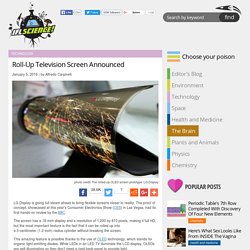
The proof of concept, showcased at this year's Consumer Electronics Show (CES) in Las Vegas, had its first hands-on review by the BBC. The screen has a 18-inch display and a resolution of 1,200 by 810 pixels, making it full HD, but the most important feature is the fact that it can be rolled up into a 3-centimeter (1.2-inch) radius cylinder without breaking the screen. This amazing feature is possible thanks to the use of OLED technology, which stands for organic light-emitting diodes. While LEDs in an LED TV illuminate the LCD display, OLEDs are self-illuminating so they don’t need a rigid back panel to provide light. Many believe that OLEDs represent the future of screens. Producing these displays is still considerably more expensive than other screens, due to a relatively low yield of functional displays.
Another problem is that the pixels in the screen are easily damaged, becoming dead pixels. Turn your Smartphone into a 3D Hologram. Cet appareil holographique vous permet de dessiner dans les airs et d’interagir avec des objets en 3D. À la City University of Hong Kong, trois étudiants ont mis au point un prototype d’engin holographique qui permet de dessiner dans les airs et d’interagir avec des objets modélisés en trois dimensions.
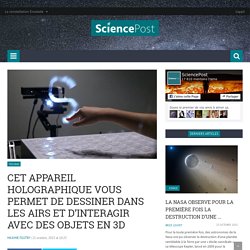
Une prouesse rendue possible grâce à l’utilisation d’un brouillard holographique, d’une caméra de profondeur et d’un projecteur. Explications. Pour tous les fans de science-fiction qui ont visionné des films comme Star Wars ou Minority Report, il est extrêmement difficile de concevoir un avenir où la communication et le transfert d’informations ne se feront pas au travers d’appareils holographiques. Et, bonne nouvelle pour ces personnes, trois étudiants de la City University of Hong Kong ont justement mis au point un prototype unique d’engin holographique qui rend cette vision du futur un peu plus tangible.
Seule ombre au tableau, cette invention n’est utilisable qu’en intérieur sous peine de voir le brouillard généré par le dispositif se dissiper par l’action du vent. This Touchable Midair 3D Laser Display Is Pretty Magical - Singularity HUB. Johnny Lee: Free or cheap Wii Remote hacks. Ri Science : Photo. Ultrasound Used To Create 3D Shapes In Mid Air That Can Be Seen And Felt. You may not have heard of it before, but haptic technology is all around us.
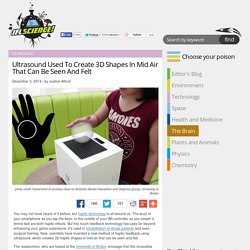
The buzz of your smartphone as you tap the keys, or the rumble of your Wii controller as you smash a tennis ball are both haptic effects. But this touch feedback technology has uses far beyond enhancing your game experience; it’s used in rehabilitation of stroke patients and even surgical training. Now, scientists have invented a new method of haptic feedback using ultrasound, which creates 3D haptic shapes in mid-air that can be seen and felt. The researchers, who are based at the University of Bristol, envisage that this innovative technology could transform the way that we use 3D haptic shapes. It could lead to touchable holograms to augment learning, or enhanced gaming experience by allowing users to feel features of the game, such as a football. 3DTouch Works In 3 Dimensions & Could Replace The Computer Mouse. University of Wyoming researchers have developed a novel wearable device, called 3DTouch, which could revolutionize the way we interact with computers.
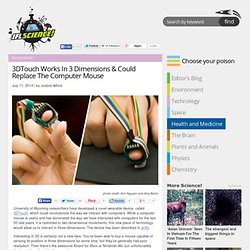
While a computer mouse is useful and has dominated the way we have interacted with computers for the last 50 odd years, it is restricted to two-dimensional movements; this new piece of technology would allow us to interact in three-dimensions. The device has been described in arXiv. How To Build A Virtual Reality System – In Your Living Room. Hologram Projectors For Your Smartphone Could Be Close. Just in time for the new Star Wars film, it seems the technology from the originals is starting to come true.
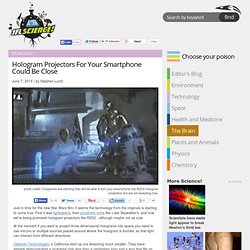
First it was lightsabers, then prosthetic arms like Luke Skywalker's, and now we're being promised hologram projectors like R2D2 - although maybe not as cute. At the moment if you want to project three dimensional holograms into space you need to use mirrors or multiple sources placed around where the hologram is formed, so that light can interact from different directions. GravitySketch Tablet Is a Portable 3D Augmented Reality Sketchpad For Designers. There’s an imposing wall dividing real world creation and digital design.
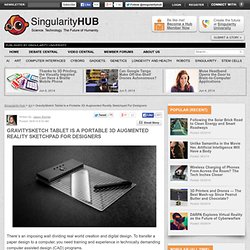
To transfer a paper design to a computer, you need training and experience in technically demanding computer assisted design (CAD) programs. Instead, imagine if we could mold digital designs in three dimensions as easily as we mold clay. Intuitive, powerful, and immersive interfaces would open the field to more people and inject more serendipity and improvisation into digital design.
Coming Soon: Tabletop Fog Screens for 3D Interactions. You might be able to watch the Game of Thrones series finale on a screen made of fog.

North of the Wall scenes have never looked more mystical. Researchers are unveiling a tabletop display with screens made from curtains of mist. By allowing you to reach through the screen, the system also creates a 3D “interaction space.”